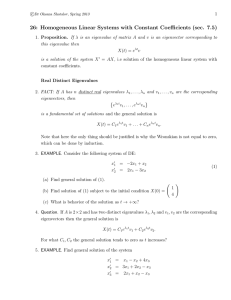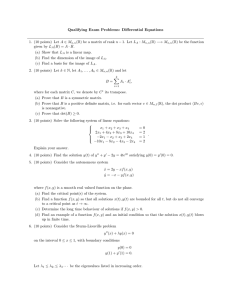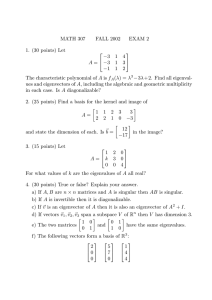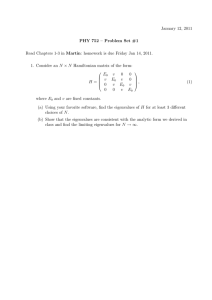Uploaded by
gvnk2006
Mathematics-II Tutorial Sheet: Eigenvalues, Matrices, Differential Equations
advertisement
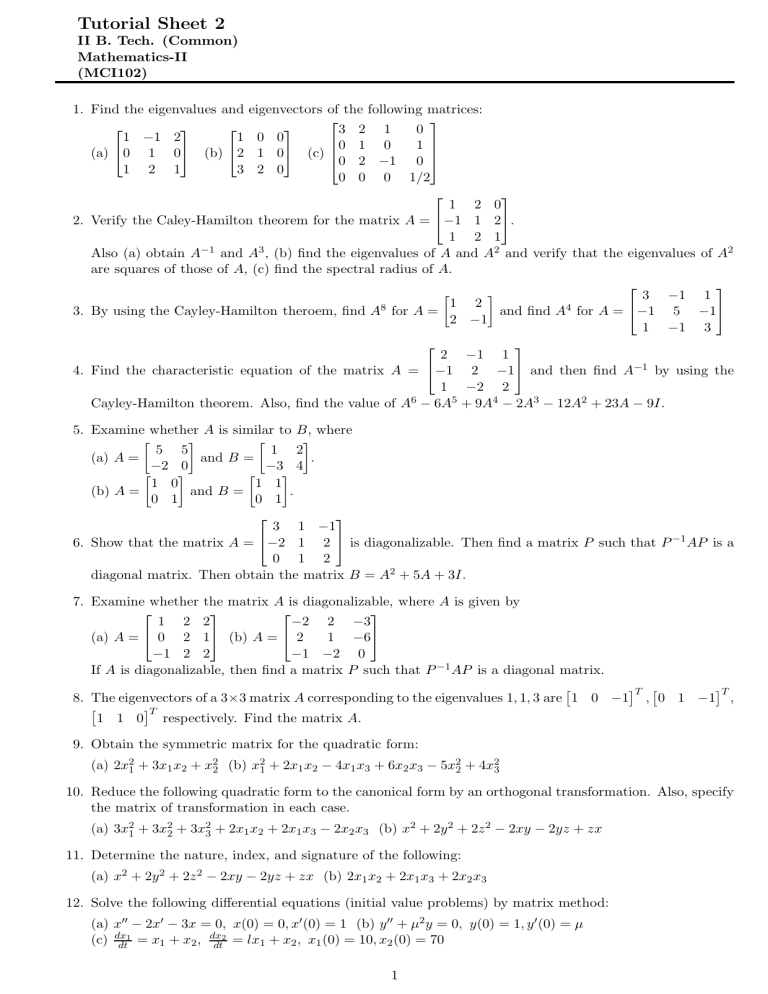
Tutorial Sheet 2 II B. Tech. (Common) Mathematics-II (MCI102) 1. Find the eigenvalues and 1 −1 2 1 (a) 0 1 0 (b) 2 3 1 2 1 eigenvectors of the following matrices: 3 2 1 0 0 0 0 1 0 1 1 0 (c) 0 2 −1 0 2 0 0 0 0 1/2 1 2 0 2. Verify the Caley-Hamilton theorem for the matrix A = −1 1 2. 1 2 1 Also (a) obtain A−1 and A3 , (b) find the eigenvalues of A and A2 and verify that the eigenvalues of A2 are squares of those of A, (c) find the spectral radius of A. 3 −1 1 1 2 3. By using the Cayley-Hamilton theroem, find A8 for A = and find A4 for A = −1 5 −1 2 −1 1 −1 3 2 −1 1 4. Find the characteristic equation of the matrix A = −1 2 −1 and then find A−1 by using the 1 −2 2 6 Cayley-Hamilton theorem. Also, find the value of A − 6A5 + 9A4 − 2A3 − 12A2 + 23A − 9I. 5. Examine whether A is similar to B, where 5 5 1 2 (a) A = and B = . −2 0 −3 4 1 0 1 1 (b) A = and B = . 0 1 0 1 3 1 −1 6. Show that the matrix A = −2 1 2 is diagonalizable. Then find a matrix P such that P −1 AP is a 0 1 2 diagonal matrix. Then obtain the matrix B = A2 + 5A + 3I. 7. Examine whether the matrix A is diagonalizable, where A is given by 1 2 2 −2 2 −3 (a) A = 0 2 1 (b) A = 2 1 −6 −1 2 2 −1 −2 0 If A is diagonalizable, then find a matrix P such that P −1 AP is a diagonal matrix. T T 8. The eigenvectors of a 3×3 matrix A corresponding to the eigenvalues 1, 1, 3 are 1 0 −1 , 0 1 −1 , T 1 1 0 respectively. Find the matrix A. 9. Obtain the symmetric matrix for the quadratic form: (a) 2x21 + 3x1 x2 + x22 (b) x21 + 2x1 x2 − 4x1 x3 + 6x2 x3 − 5x22 + 4x23 10. Reduce the following quadratic form to the canonical form by an orthogonal transformation. Also, specify the matrix of transformation in each case. (a) 3x21 + 3x22 + 3x23 + 2x1 x2 + 2x1 x3 − 2x2 x3 (b) x2 + 2y 2 + 2z 2 − 2xy − 2yz + zx 11. Determine the nature, index, and signature of the following: (a) x2 + 2y 2 + 2z 2 − 2xy − 2yz + zx (b) 2x1 x2 + 2x1 x3 + 2x2 x3 12. Solve the following differential equations (initial value problems) by matrix method: (a) x′′ − 2x′ − 3x = 0, x(0) = 0, x′ (0) = 1 (b) y ′′ + µ2 y = 0, y(0) = 1, y ′ (0) = µ dx2 1 (c) dx dt = x1 + x2 , dt = lx1 + x2 , x1 (0) = 10, x2 (0) = 70 1 13. Show that: (a) The eigenvalues of a Hermitian matrix are real. (b) The eigenvalues of a skew-Hermitian matrix are zero or pure imaginary. (c) The eigenvalues of a unitary matrix are of magnitude 1. 2 −2 −4 1 1 (d) −3 3 4 is an idempotent matrix. Also, show that is involutory. 0 −1 1 −2 −2 (e) Every skew-Hermitian matrix A can be expressed as B + iC, where B is real skew-symmetric matrix and C is real symmetric matrix. (f) λ = 0 is an eigenvalue of a matrix A if and only if A is a singular matrix. 0 2b c 14. Determine the values of a, b, and c if the matrix a b −c is orthogonal. a −b c 2
